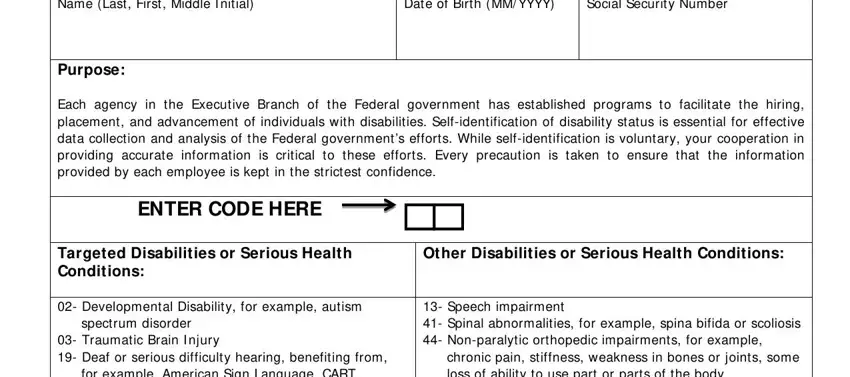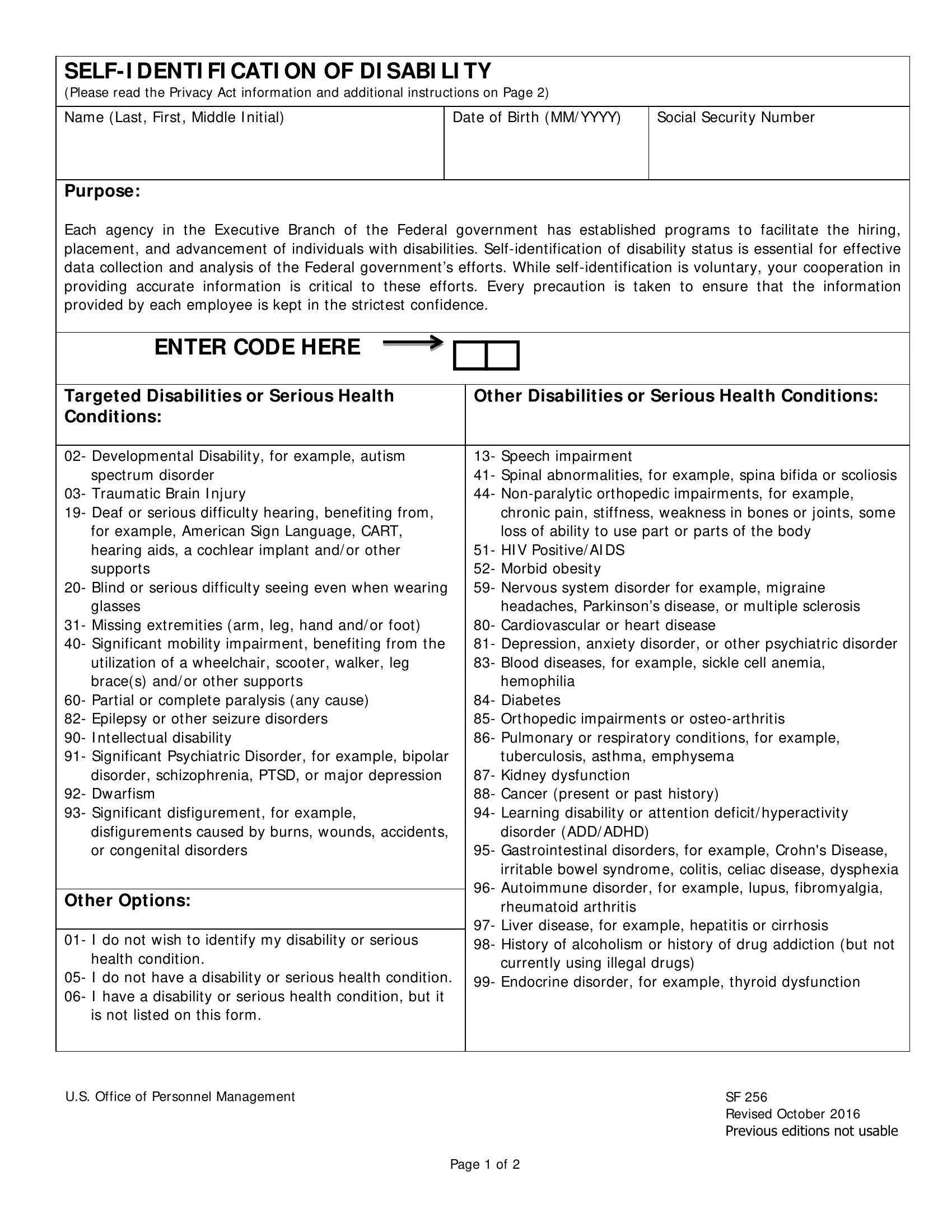SELF- I DENTI FI CATI ON OF DI SABI LI TY
(Please read the Privacy Act information and additional instructions on Page 2)
Name (Last, First , Middle I nitial)
Purpose:
Each agency in the Executive Branch of t he Federal government has established programs t o facilitate the hiring, placement, and advancement of individuals with disabilities. Self-identification of disability status is essential for effective data collection and analysis of t he Federal government ’s efforts. While self-identification is voluntary, your cooperation in providing accurate information is critical to these efforts. Every precaution is taken to ensure that the information provided by each employee is kept in t he strictest confidence.
ENTER CODE HERE
|
Targeted Disabilities or Serious Health |
Other Disabilities or Serious Health Conditions: |
|
Conditions: |
|
|
|
|
|
02- Developmental Disabilit y, for example, autism |
13- Speech impairment |
|
spectrum disorder |
41- Spinal abnormalities, for example, spina bifida or scoliosis |
|
03- Traumatic Brain I njury |
44- Non-paralytic orthopedic impairments, for example, |
|
19- Deaf or serious difficult y hearing, benefiting from, |
chronic pain, stiffness, weakness in bones or joints, some |
|
for example, American Sign Language, CART, |
loss of ability to use part or parts of the body |
|
hearing aids, a cochlear implant and/ or other |
51- HI V Positive/ AI DS |
|
supports |
52- Morbid obesit y |
|
20- Blind or serious difficult y seeing even when wearing |
59- Nervous system disorder for example, migraine |
|
glasses |
headaches, Parkinson’s disease, or multiple sclerosis |
|
31- Missing extremities (arm, leg, hand and/ or foot) |
80- Cardiovascular or heart disease |
|
40- Significant mobility impairment, benefiting from t he |
81- Depression, anxiety disorder, or other psychiatric disorder |
|
utilization of a wheelchair, scooter, walker, leg |
83- Blood diseases, for example, sickle cell anemia, |
|
brace(s) and/ or other supports |
hemophilia |
|
60- Partial or complete paralysis (any cause) |
84- Diabetes |
|
82- Epilepsy or ot her seizure disorders |
85- Ort hopedic impairment s or osteo-arthritis |
|
90- I ntellectual disability |
86- Pulmonary or respiratory conditions, for example, |
|
91- Significant Psychiatric Disorder, for example, bipolar |
tuberculosis, ast hma, emphysema |
|
disorder, schizophrenia, PTSD, or major depression |
87- Kidney dysfunction |
|
92- Dwarfism |
88- Cancer (present or past history) |
|
93- Significant disfigurement, for example, |
94- Learning disability or attention deficit/ hyperactivit y |
|
disfigurements caused by burns, wounds, accidents, |
disorder (ADD/ ADHD) |
|
or congenital disorders |
95- Gastrointestinal disorders, for example, Crohn's Disease, |
|
|
irritable bowel syndrome, colitis, celiac disease, dysphexia |
|
|
96- Autoimmune disorder, for example, lupus, fibromyalgia, |
|
Other Options: |
|
rheumatoid arthritis |
|
|
|
|
97- Liver disease, for example, hepatitis or cirrhosis |
|
01- I do not wish to identify my disabilit y or serious |
|
98- History of alcoholism or history of drug addiction ( but not |
|
|
|
health condition. |
currently using illegal drugs) |
|
|
|
05- I do not have a disabilit y or serious health condition. |
99- Endocrine disorder, for example, thyroid dysfunction |
|
|
|
06- I have a disability or serious health condition, but it |
|
|
is not listed on this form. |
|
|
|
|
U.S. Office of Personnel Management |
SF 256 |
|
Revised October 2016 |
|
Previous editions not usable |
Definit ion
An individual with a disability: A person who (1) has a physical or mental impairment which substantially limits one or more major life activities; ( 2) has a record of such an impairment; or (3) is regarded as having such an impairment . This definition is provided by the Rehabilitation Act of 1973, as amended (29 U.S.C. 701, et seq.) .
The Rehabilitation Act of 1973
The Rehabilitation Act of 1973, as amended (29 U.S.C. 701, et seq.), requires each agency in the Executive Branch of the Federal government to establish programs that will facilitate the hiring, placement, and advancement of individuals with disabilities. One met hod for determining agency progress in fulfilling these requirements is through the production of reports at certain intervals showing, for example, the number of employees with disabilities who are hired, promoted, trained, or reassigned over a given time period; the percentage of employees with disabilities in the work force and in various grades and occupations; et c. Such reports bring to t he attention of agency t op management, OPM, and t he Congress, the progress or any deficiencies within specific agencies or the Federal government as a whole in the hiring, placement, and advancement of individuals with disabilities.
The disability data collect ed on employees will be used only in t he production of reports such as those previously mentioned and not for any purpose that will affect them individually. The only exception to this rule is that the records may be used for selective placement purposes and selecting special populations for mailing of voluntary personnel research surveys. I n addition, every precaution will be taken to ensure t hat the information provided by each employee is kept in t he strictest confidence and is known only to those individuals in the agency Personnel Office, who obtain and record the information for entry into the agency’s and OPM’s personnel syst ems. You should also be aware that participation in the disability reporting system is entirely voluntary, with the exception of employees appoint ed under the Schedule A Excepted Appointing Authorit y for People with I ntellect ual Disabilit y, Severe Physical Disabilit y, or Psychiatric Disability (5 CFR 213.3102(u)) . Agencies will request that these employees identify t heir disability status and, if they decline to do so, t heir correct disability code will be obtained from medical documentation used to support their appointment .
Employees who wish to confirm the disability code carried in their agency’s and OPM’s personnel systems is consistent with the employees’ representation, may ask their Personnel Officer for a printout of the code and definition from t heir individual records. The code noted in the employees’ records in t he agencies’ system will be identical to that carried in OPM’s system.
Privacy Act Stat ement
Collection of the requested information is aut horized by the Rehabilitation Act of 1973, as amended (29 U.S.C. 701, et seq.) . Solicitation of your Social Security Number (SSN) is authorized by Executive Order 9397, which permits agencies to use the SSN as a means for identifying persons with disabilities in personnel information systems. Your SSN will only be used to ensure that your correct disability code is recorded along with other employee information that your agency and OPM maintain on you. I t should be noted, however, that where individuals decline to furnish their SSN, the SSN will be obtained from other records in order to ensure accurate and complete data. Employees appointed under the Schedule A Appointing Authorit y for People with I ntellectual Disability, Severe Physical Disability, or Psychiatric Disability (5 CFR 213.3102(u)) are requested to furnish an accurate disability code, but failure to do so will not affect them. Where employees hired under this authority fail to disclose their disability, the appropriate code will be determined from the employee’s existing records or medical documentation submitted upon appointment .
U.S. Office of Personnel Management |
SF 256 |
|
Revised October 2016 |
|
Previous editions not usable |
|
Page 2 of 2 |



